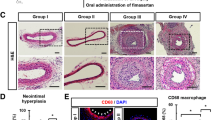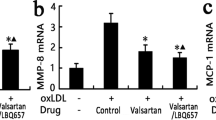Abstract
The beneficial effects of losartan and rosuvastatin on neointimal formation have been well characterized, but little is known about the combined treatment benefit of these two drugs. This study was designed to investigate the synergistic effect of losartan combined with rosuvastatin on the magnitude of protective action in vascular injury mediated by cuff-induced neointimal formation model in vivo. Losartan at 20 mg/kg or rosuvastatin at 40 mg/kg significantly decreased both the neointimal formation and BrdU-positive cells in neointima, indicating the inhibition of cell proliferation including a progress of DNA synthesis. The combination treatment used lower doses of losartan with rosuvastatin (10 + 20 & 5 + 10 mg/kg, respectively) that proved to be significant in decreasing the neointimal formation and BrdU incorporation. These results were comparable to the diminution attained with monotherapy of either drug in higher doses. Interaction index measured by isobolar method indicated drug synergism in these two combinations of both drugs at lower doses. Therefore, the administration of losartan and rosuvastatin in combination with low doses synergistically decreased in cuffinduced neointimal formation by reducing cell proliferation, suggesting that this drug synergism may be fully effective with, lower adverse effects, for the treatment of vascular remodeling such as restenosis.
Similar content being viewed by others
References
Akishita, M., Horiuchi, M., Yamada, H., Zhang, L., Shirakami, G., Tamura, K., Ouchi, Y., and Dzau, V. J., Inflammation influences vascular remodeling through AT2 receptor expression and signaling. Physiol. Genomics, 2, 13–20 (2000).
Akishita, M., Ouchi, Y., Miyoshi, H., Kozaki, K., Inoue, S., Ishikawa, M., Eto, M., Toba, K., and Orimo, H., Estrogen inhibits cuff-induced intimal thickening of rat femoral artery: effects on migration and proliferation of vascular smooth muscle cells. Atherosclerosis, 130, 1–10 (1997).
Bustos, C., Hernández-Presa, M. A., Ortego, M., Tunon, J., Ortega, L., Pérez, F., Díaz, C., Hernández, G., and Egido, J., HMG-CoA reductase inhibition by atorvastatin reduces neointimal inflammation in a rabbit model of atherosclerosis. J. Am. Coll. Cardiol., 32, 2057–2064 (1998).
Calkin, A. C., Giunti, S., Sheehy, K. J., Chew, C., Boolell, V., Rajaram, Y. S., Cooper, M. E., and Jandeleit-Dahm, K. A., The HMG-CoA reductase inhibitor rosuvastatin and the angiotensin receptor antagonist candesartan attenuate atherosclerosis in an apolipoprotein E-deficient mouse model of diabetes via effects on advanced glycation, oxidative stress and inflammation. Diabetologia, 51, 1731–1740 (2008).
Chen, H., Li, D., Sawamura, T., Inoue, K., and Mehta, J. L., Upregulation of LOX-1 expression in aorta of hypercholesterolemic rabbits: Modulation by losartan. Biochem. Biophys. Res. Commun., 276, 1100–1104 (2000).
De Gasparo, M., Catt, K. J., Inagami, T., Wright, J. W., and Unger, T., International union of pharmacology, XXIII: the angiotensin II receptors. Pharmacol. Rev., 52, 415–472 (2000).
Egashira, K., Zhao, Q., Kataoka, C., Ohtani, K., Usui, M., Charo, I. F., Nishida, K., Inoue, S., Katoh, M., Ichiki, T., and Takeshita, A., Importance of monocyte chemoattractant protein-1 pathway in neointimal hyperplasia after periarterial injury in mice and monkeys. Circ. Res., 90, 1167–1172 (2002).
Hirosumi, J., Nomoto, A., Ohkubo, Y., Sekiguchi, C., Mutoh, S., Yamaguchi, I., and Aoki, H., Inflammatory responses in cuff-induced atherosclerosis in rabbits. Atherosclerosis, 64, 243–254 (1987).
Horiuchi, M., Cui, T. X., Li, Z., Li, J. M., Nakagami, H., and Iwai, M., Fluvastatin enhances the inhibitory effects of a selective angiotensin II type 1 receptor blocker, valsartan, on vascular neointimal formation. Circulation, 107, 106–112 (2003).
Igarashi, M., Hirata, A., Yamaguchi, H., Tsuchiya, H., Ohnuma, H., Tominaga, M., Daimon, M., and Kato, T., Candesartan inhibits carotid intimal thickening and ameliorates insulin resistance in balloon-injured diabetic rat. Hypertension, 38, 1255–1259 (2001).
Igase, M., Kohara, K., Nagai, T., Miki, T., and Ferrario, C. M., Increased expression of angiotensin converting enzyme 2 in conjunction with reduction of neointima by angiotensin II type 1 receptor blockade. Hypertens. Res., 31, 553–559 (2008).
Indolfi, C., Cioppa, A., Stabile, E., Di Lorenzo, E., Esposito, G., Pisani, A., Leccia, A., Cavuto, L., Stingone, A. M., Chieffo, A., Capozzolo, C., and Chiariello, M., Effects of hydroxymethylglutaryl coenzyme A reductase inhibitor simavastatin on smooth muscle cell proliferation in vitro and neointimal formation in vivo after vascular injury. J. Am. Coll. Cardiol., 35, 214–221 (2000).
Jaschke, B., Michaelis, C., Milz, S., Vogeser, M., Mund, T., Hengst, L., Kastrati, A., Schömig, A., and Wessely, R., Local statin therapy differentially interferes with smooth muscle and endothelial cell proliferation and reduces neointima on a drug-eluting stent platform. Cardiovasc. Res., 68, 483–492 (2005).
Jinno, T., Iwai, M., Li, Z., Li, J. M., Liu, H. W., Cui, T. X., Rakugi, H., Ogihara, T., and Horiuchi, M., Calcium channel blocker azelnidipine enhances vascular protective effects of AT1 receptor blocker olmesartan. Hypertension, 43, 263–269 (2004).
Kauffman, R. F., Bean, J. S., Zimmerman, K. M., Brown, R. F., and Steinberg, M. I., Losartan, a nonpeptide angiotensin II (Ang II) receptor antagonist, inhibits neointima formation following balloon injury to rat carotid arteries. Life Sci., 49, PL223–PL228 (1991).
Kiyan, J., Kusch, A., Tkachuk, S., Krämer, J., Haller, H., Dietz, R., Smith, G., and Dumler, I., Rosuvastatin regulates vascular smooth muscle cell phenotypic modulation in vascular remodeling: role for the urokinase receptor. Atherosclerosis, 195, 254–261 (2007).
Kleemann, R., Princen, H. M., Emeis, J. J., Jukema, J. W., Fontijn, R. D., Horrevoets, A. J., Kooistra, T., and Havekes, L. M., Rosuvastatin reduces atherosclerosis development beyond and independent of its plasma cholesterol-lowering effect on APOE*3-leiden transgenic mice: Evidence for antiinflammatory effects of rosuvastatin. Circulation, 108, 1368–1374 (2003).
Koh, K. K., Quon, M. J., Han, S. H., Chung, W. J., Ahn, J. Y., Seo, Y. H., Kang, M. H., Ahn, T. H., Choi, I. S., and Shin, E. K., Additive beneficial effects of losartan combined with simvastatin in the treatment of hypercholesterolemic, hypertensive patients. Circulation, 110, 3687–3692 (2004).
Lemay, J., Hamet, P., and Deblois, D., Losartan-induced apoptosis as a novel mechanism for the prevention of vascular lesion formation after injury. J. Renin Angiotensin Aldosterone Syst., 1, 46–50 (2000).
Matsuno, H., Kozawa, O., Niwa, M., Kaida, T., Hayashi, H., and Uematsu, T., GR144053, a fibrinogen receptor antagonist, enhances the suppression of neointima formation by losartan, an angiotensin II receptor antagonist, in the injured carotid artery of hamster. Br. J. Pharmacol., 122, 1099–1104 (1997).
Moon, M. C., Molnar, K., Yau, L., and Zahradka, P., Perivascular delivery of losartan with surgical fibrin glue prevents neointimal hyperplasia after arterial injury. J. Vasc. Surg., 40, 130–137 (2004).
Nakajima, M., Hutchinson, H., Fujinaga, M., Hayashida, W., Morishita, R., Zhang, L., Horiuchi, M., Pratt, R. E., and Dzau, V. J., The angiotensin II type 2 (AT2) receptor antagonizes the growth effects of the AT1 receptor: gain of function study using in vivo gene transfer. Proc. Natl. Acad. Sci. USA, 92, 10663–10667 (1995).
Nishimura, T., Vaszar, L. T., Faul, J. L., Zhao, G., Berry, G. J., Shi, L., Qiu, D., Benson, G., Pearl, R. G., and Kao, P. N., Simvastatin rescues rats from fatal pulmonary hypertension by inducing apoptosis of neointimal smooth muscle cells. Circulation, 108, 1640–1645 (2003).
Noa, M., Mas, R., and Mesa, R., A comparative study of policosanol vs lovastatin on intimal thickening in rabbit cuffed carotid artery. Pharmacol. Res., 43, 31–37 (2001).
Ohtani, K., Egashira, K., Ihara, Y., Nakano, K., Funakoshi, K., Zhao, G., Sata, M., and Sunagawa, K., Angiotensin II type 1 receptor blockade attenuates in-stent restenosis by inhibiting inflammation and progenitor cells. Hypertension, 48, 664–670 (2006).
Oparil, S., Chen, S. J., Chen, Y. F., Durand, J. N., Allen, L., and Thompson, J. A., Estrogen attenuates the adventitial contribution to neointima formation in injured rat carotid arteries. Cardiovasc. Res., 44, 608–614 (1999).
Pickering, J. G., Weir, L., Jekanowski, J., Kearney, M. A., and Isner, J. M., Proliferative activity in peripheral and coronary atherosclerotic plaque among patients undergoing percutaneous revascularization. J. Clin. Invest., 91, 1469–1480 (1993).
Porter, K. E., Naik, J., Turner, N. A., Dickinson, T., Thompson, M. M., and London, N. J., Simvastatin inhibits human saphenous vein neointima formation via inhibition of smooth muscle cell proliferation and migration. J. Vasc. Surg., 36, 150–157 (2002).
Prescott, M. F., Webb, R. L., and Reidy, M. A., Angiotensinconverting enzyme inhibitor versus angiotensin II, AT1 receptor antagonist. Effects on smooth muscle cell migration and proliferation after balloon catheter injury. AM. J. Pathol., 139, 1291–1296 (1991).
Schäfer, K., Kaiser, K., and Konstantinides, S., Rosuvastatin exerts favourable effects on thrombosis and neointimal growth in a mouse model of endothelial injury. Thromb. Haemost., 93, 145–152 (2005).
Tallarida, R. J., The interaction index: a measure of drug synergism. Pain, 98, 163–168 (2002).
Van der Harst, P., Groenewegen, H. C., Roks, A. J., Buikema, H., Zijlstra, F., van Gilst, W. H., and De Smet, B. J., Rosuvastatin attenuates angiotensin II-induced neointimal formation after stent implantation in the rat. Coron. Artery Dis., 19, 47–53 (2008).
Van Kleef, E. M., Fingerle, J., and Daemen, M. J., Angiotensin II-induced progression of neointimal thickening in the ballon-injured rat carotid artery is AT1 receptor mediated. Arterioscler. Thromb. Vasc. Biol., 16, 857–863 (1996).
Wu, L., Iwai, M., Nakagami, H., Li, Z., Chen, R., Suzuki, J., Akishita, M., De Gasparo, M., and Horiuchi, M. Roles of angiotensin II type 2 receptor stimulation associated with selective angiotensin II type 1 receptor blockade with valsartan in the improvement of inflammation-induced vascular injury. Circulation, 104, 2716–2721 (2001).
Yamada, T., Kondo, T., Numaguchi, Y., Tsuzuki, M., Matsubara, T., Manabe, I., Sata, M., Nagai, R., and Murohara, T., Angiotensin II receptor blocker inhibits neointimal hyperplasia through regulation of smooth muscle-like progenitor cells. Arterioscler. Thromb. Vasc. Biol., 27, 2363–2369 (2007).
Yoshida, O., Hirayama, H., Nanasato, M., Watanabe, T., and Murohara, T., The angiotensin II receptor blocker candesartan cilexetil reduces neointima proliferation after coronary stent implantation: A prospective randomized study under intravascular ultrasound guidance. Am. Heart J., 149, e1–6 (2005).
Author information
Authors and Affiliations
Corresponding author
Additional information
These authors contributed equally to this work.
Rights and permissions
About this article
Cite this article
Yi, I., Lee, JJ., Park, JS. et al. Enhanced effect of losartan and rosuvastatin on neointima hyperplasia. Arch. Pharm. Res. 33, 593–600 (2010). https://doi.org/10.1007/s12272-010-0414-z
Received:
Revised:
Accepted:
Published:
Issue Date:
DOI: https://doi.org/10.1007/s12272-010-0414-z




